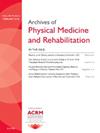Uphill Treadmill Running and Joint Mobilization Improve Dynamic Stability and Ankle Dorsiflexion Range of Motion in Young Adults With Chronic Ankle Instability: A Four-Arm Randomized Controlled Trial
IF 3.7
2区 医学
Q1 REHABILITATION
Archives of physical medicine and rehabilitation
Pub Date : 2025-02-01
DOI:10.1016/j.apmr.2024.08.025
引用次数: 0
Abstract
Objective
To observe the effect of uphill running and the combined effect of uphill running plus joint mobilizations on dynamic stability and ankle dorsiflexion in young adults with chronic ankle instability (CAI).
Design
Four-arm randomized controlled trial.
Setting
A college rehabilitation center.
Participants
Individuals with CAI (N=73).
Interventions
Participants were randomly assigned to 4 groups: combined uphill running and joint mobilization (URJM), uphill running alone (UR), joint mobilization alone (JM), and control group. The URJM and UR groups received 20-minute running sessions, and the URJM and JM groups received ankle joint mobilizations, all 3 times a week for 4 weeks.
Main Outcome Measures
Cumberland Ankle Instability Tool (CAIT) and Y-balance test (YBT) in anterior, posteromedial (PM), and posterolateral (PL) directions for dynamic stability; weight-bearing lunge test and non-weight-bearing ankle dorsiflexion degree using a goniometer (NWBG) for dorsiflexion.
Results
The UR group showed significant improvements in CAIT, YBT-PL, YBT-PM, and NWBG compared to the control group. The URJM group demonstrated large treatment effects in NWBG compared to both UR and JM groups. Responder analysis indicated that the UR, JM, and URJM groups had a higher likelihood of achieving clinically significant changes (exceeding minimal detectable change or minimal clinically important difference) in CAIT, YBT-PM, YBT-PL, and NWBG compared with the control group. Additionally, the combination of UR and JM was superior to either intervention alone for NWBG, with success rates 1.55 times greater than UR alone and 2.08 times greater than JM alone.
Conclusions
A 4-week UR program improves the subjective feeling of instability, dynamic postural control, and ankle dorsiflexion in young adults with CAI. Compared to UR or JM alone, their combined application can better improve the non-weight-bearing ankle dorsiflexion range of motion.
上坡跑步和关节活动可改善慢性踝关节不稳定的年轻成年人的动态稳定性和踝关节外展活动范围:四臂随机对照试验。
目的观察上坡跑以及上坡跑加关节活动对慢性踝关节不稳定(CAI)年轻成人的动态稳定性和踝关节外展的综合影响:设计:四臂随机对照试验:参与者:CAI 患者(73 人):参与者被随机分配到四组:联合上坡跑步和关节动员组(URJM)、单独上坡跑步组(UR)、单独关节动员组(JM)和对照组。URJM组和UR组接受20分钟的跑步训练,URJM组和JM组接受踝关节活动,每周三次,共4周:坎伯兰踝关节不稳定性工具(CAIT)和Y-平衡测试(YBT)在前方、后内侧(PM)和后外侧(PL)方向的动态稳定性;负重弓步测试和使用动态关节角度计(NWBG)的非负重踝关节背屈程度:与对照组相比,UR组在CAIT、YBT-PL、YBT-PM和NWBG方面均有明显改善。与 UR 组和 JM 组相比,URJM 组在 NWBG 方面表现出较大的治疗效果。应答者分析表明,与对照组相比,UR、JM 和 URJM 组在 CAIT、YBT-PM、YBT-PL 和 NWBG 方面实现临床显著变化(超过最小可检测变化或最小临床重要差异)的可能性更高。此外,就 NWBG 而言,UR 和 JM 的组合优于单独的干预,成功率是单独 UR 的 1.55 倍,是单独 JM 的 2.08 倍:结论:为期4周的UR项目可改善CAI年轻成人的主观不稳定感、动态姿势控制和踝关节外展。与单独使用 UR 或 JM 相比,两者结合使用能更好地改善非负重踝关节背屈的活动范围。
本文章由计算机程序翻译,如有差异,请以英文原文为准。
求助全文
约1分钟内获得全文
求助全文
来源期刊
CiteScore
6.20
自引率
4.70%
发文量
495
审稿时长
38 days
期刊介绍:
The Archives of Physical Medicine and Rehabilitation publishes original, peer-reviewed research and clinical reports on important trends and developments in physical medicine and rehabilitation and related fields. This international journal brings researchers and clinicians authoritative information on the therapeutic utilization of physical, behavioral and pharmaceutical agents in providing comprehensive care for individuals with chronic illness and disabilities.
Archives began publication in 1920, publishes monthly, and is the official journal of the American Congress of Rehabilitation Medicine. Its papers are cited more often than any other rehabilitation journal.

 求助内容:
求助内容: 应助结果提醒方式:
应助结果提醒方式:


